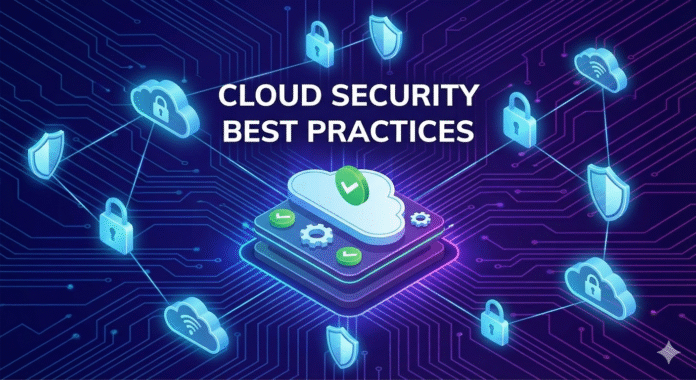
Photo by panumas nikhomkhai via Pexels
Introduction: The Critical Importance of Cloud Security in 2025
As organizations continue migrating critical workloads to cloud environments, cloud security has evolved from a technical consideration to a business imperative. With over 90% of enterprises now using multi-cloud strategies and cyber threats growing in sophistication, implementing comprehensive cloud security best practices is no longer optional.
The stakes have never been higher. Data breaches in cloud environments can cost organizations millions in remediation, regulatory fines, and reputational damage.
Understanding the Cloud Shared Responsibility Model
What Cloud Providers Secure (Security OF the Cloud)
- Physical infrastructure security (data centers, hardware, facilities)
- Networking infrastructure (routers, switches, load balancers)
- Virtualization layer (hypervisors, host OS)
- Managed services infrastructure
What Customers Must Secure (Security IN the Cloud)
- Identity and Access Management (IAM) configurations
- Data encryption (at rest and in transit)
- Network security controls (firewalls, security groups)
- Application security
- Compliance with regulations
Critical Insight: Most cloud security breaches result from customer misconfigurations, not cloud provider failures.
Foundational Cloud Security Principles
1. Zero Trust Architecture
Zero Trust operates on: “Never trust, always verify.”
Core Zero Trust Principles:
- Verify explicitly: Authenticate and authorize based on all available data
- Least privileged access: Grant minimum necessary permissions
- Assume breach: Minimize blast radius and segment access
- Continuous monitoring: Real-time security analytics
2. Defense in Depth
Layer multiple security controls:
- Network security: Firewalls, security groups, network ACLs
- Identity security: MFA, conditional access, privileged access management
- Data security: Encryption, tokenization, data loss prevention
- Application security: WAF, API gateways, runtime protection
- Monitoring: SIEM, log aggregation, threat intelligence
Identity and Access Management (IAM) Best Practices
IAM is the cornerstone of cloud security. Compromised credentials remain a leading attack vector.
AWS Identity and Access Management
Key Recommendations:
- Implement least privilege access policies
- Use IAM roles instead of access keys
- Enable MFA for all users
- Use AWS Organizations with Service Control Policies
- Deploy GuardDuty for threat detection
- Use IAM Access Analyzer for policy review
Microsoft Azure Active Directory and RBAC
Key Recommendations:
- Implement Azure AD Conditional Access
- Deploy Privileged Identity Management (PIM)
- Use Azure RBAC with least privilege
- Enable Managed Identities for applications
- Deploy Microsoft Defender for Cloud
Google Cloud Identity and Access Management
Key Recommendations:
- Use Cloud IAM hierarchy effectively
- Implement short-lived service account keys
- Deploy VPC Service Controls
- Use Policy Intelligence tools
- Enable Security Command Center
Network Security Best Practices
Virtual Private Cloud (VPC) Security
1. Network Segmentation
Design VPCs with security zones:
- Public subnets: Internet-facing load balancers, bastion hosts
- Private subnets: Application servers, business logic
- Isolated/data subnets: Databases, data warehouses
- Management subnet: Security tools, logging infrastructure
2. Security Groups Best Practices
- Default deny all; explicitly allow required traffic
- Reference security groups rather than IP ranges
- Regular security group audits
- Document security group purpose
3. Private Endpoints
- AWS PrivateLink, Azure Private Endpoints, Google Cloud Private Service Connect
- Access cloud services without internet exposure
- Prevent data exfiltration risks
Data Encryption and Protection
Encryption at Rest
Enable Default Encryption for All Storage:
AWS:
- S3: Enable default bucket encryption (SSE-KMS)
- EBS: Enable volume encryption by default
- RDS: Enable storage encryption for databases
Azure:
- Blob Storage: Storage Service Encryption
- Azure SQL: Transparent Data Encryption (TDE)
- Managed Disks: Azure Disk Encryption
Google Cloud:
- Cloud Storage: Automatic encryption at rest
- Compute Engine: Encrypted persistent disks
- Cloud SQL: Automatic data encryption
Customer-Managed Encryption Keys
- AWS KMS: Customer Master Keys with rotation
- Azure Key Vault: Key management with HSM options
- Google Cloud KMS: Centralized cryptographic key management
Cloud Security Monitoring and Incident Response
Centralized Logging and SIEM
AWS Logging:
- CloudTrail: API activity logging
- CloudWatch Logs: Application and infrastructure logs
- VPC Flow Logs: Network traffic logging
- GuardDuty Findings: Threat detection alerts
Azure Logging:
- Activity Logs: Subscription-level operations
- Diagnostic Logs: Resource-level operations
- Microsoft Sentinel: Cloud-native SIEM
Google Cloud Logging:
- Cloud Audit Logs: Admin activity and data access
- Cloud Logging: Unified logging service
- Security Command Center: Centralized security findings
Common Cloud Security Mistakes to Avoid
- Overly Permissive IAM Policies – Grant minimum necessary access
- Unencrypted Data Storage – Enable encryption at rest everywhere
- Publicly Exposed Resources – Regular scanning for public exposure
- Insufficient Logging – Centralized logging is mandatory
- Lack of Network Segmentation – Multi-tier architecture required
- Ignoring Shared Responsibility – Understand what YOU must secure
- No Incident Response Plan – Written procedures are essential
- Poor Secrets Management – Use cloud-native secrets services
Cloud Security Implementation Roadmap
Month 1: Foundational Security
- Enable MFA for all accounts
- Implement least privilege IAM
- Enable comprehensive logging
- Enable default encryption
- Configure security groups with deny-by-default
Month 2: Enhanced Controls
- Implement private endpoints
- Deploy Web Application Firewall
- Enable vulnerability scanning
- Set up SIEM/security analytics
- Configure automated alerting
Month 3: Advanced Security
- Implement Infrastructure as Code security
- Deploy automated remediation
- Establish Zero Trust architecture
- Conduct incident response exercises
Conclusion: Cloud Security as Continuous Journey
Cloud security is not a one-time implementation but a continuous journey requiring ongoing attention, adaptation, and improvement. As threats evolve and cloud platforms introduce new services, security strategies must evolve in parallel.
Key Principles for Success:
- Adopt Zero Trust architecture
- Automate security controls relentlessly
- Monitor continuously with centralized logging
- Embrace shared responsibility model
- Prioritize data encryption and access controls
Organizations that treat cloud security as strategic priority will be best positioned to leverage cloud benefits while managing risks effectively.
Sources: Microsoft Learn Azure Security Benchmark, AWS Well-Architected Framework, Google Cloud Security Documentation, Cloud Security Alliance
